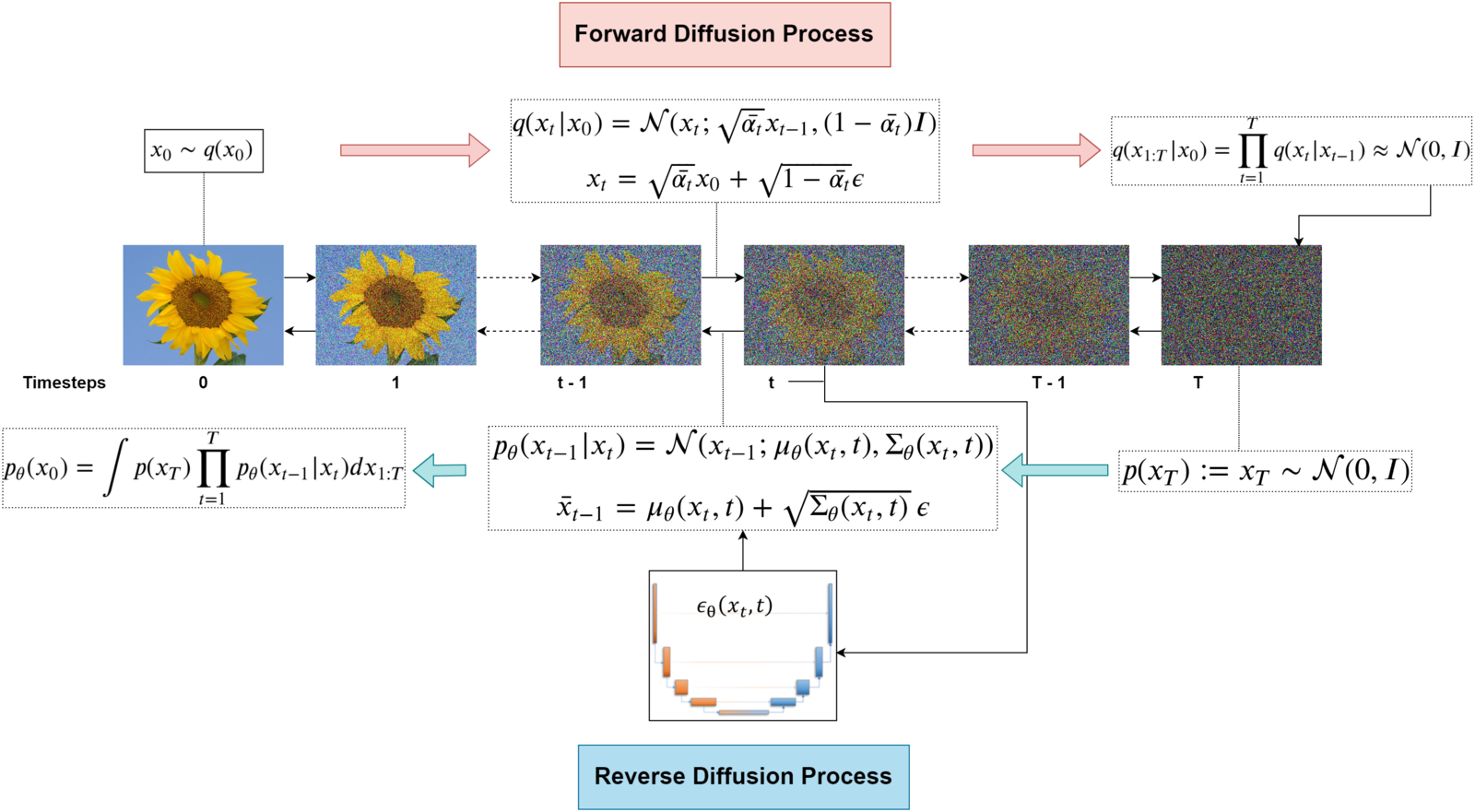DDPM¶
Diffusion Image Generation
- class lucid.models.imggen.DDPM(model: Module | None = None, image_size: int = 32, channels: int = 3, timesteps: int = 1000, diffuser: Module | None = None, clip_denoised: bool = True)¶
The DDPM class implements a Denoising Diffusion Probabilistic Model, following the original formulation by Ho et al. (2020). It is designed for image generation through iterative denoising of Gaussian-noised data.
This implementation is modular and supports custom noise prediction models and diffusion schedules, while defaulting to a U-Net and linear Gaussian \(\beta\)-schedule.
Total Parameters: 20,907,649 (Default)

Class Signature¶
class DDPM(
model: nn.Module | None = None,
image_size: int = 32,
channels: int = 3,
timesteps: int = 1000,
diffuser: nn.Module | None = None,
clip_denoised: bool = True,
)
Parameters¶
model (nn.Module | None): The noise prediction model \(\epsilon_\theta(\mathbf{x}_t, t)\). If not given, a default UNet is used.
Required forward signature:
def forward(self, x: Tensor, t: Tensor) -> Tensor
where x is of shape (N, C, H, W) and t of shape (N,).
image_size (int): Size of the (square) input image.
channels (int): Number of channels in the input image.
timesteps (int): Total number of diffusion steps. Controls the length of the forward/reverse process.
diffuser (nn.Module | None): Module implementing the diffusion process. If not provided, defaults to GaussianDiffuser.
Required methods in diffuser:
def sample_timesteps(self, batch_size: int) -> Tensor def add_noise(self, x_start: Tensor, t: Tensor, noise: Tensor) -> Tensor def denoise(self, model: nn.Module, x: Tensor, t: Tensor, clip_denoised: bool) -> Tensor
clip_denoised (bool): Whether to clip final denoised outputs to [0, 1].
Returns¶
Use the forward method for training loss:
loss = ddpm(x)
loss (Tensor): MSE loss between true and predicted noise in the denoising process.
Sampling is performed using:
samples = ddpm.sample(batch_size)
samples (Tensor): A tensor of shape (N, C, H, W) containing generated images.
Forward Noise Process¶
To diffuse a clean image \(\mathbf{x}_0\), noise is incrementally added:
where \(\bar{\alpha}_t = \prod_{s=1}^{t} \alpha_s\), and each \(\alpha_t = 1 - \beta_t\).
The function diffuser.add_noise() implements this process.
Reverse Denoising Process¶
The model predicts the added noise \(\epsilon_\theta(\mathbf{x}_t, t)\) and reconstructs an estimate of the original image:
Then, a new sample \(\mathbf{x}_{t-1}\) is drawn:
with \(\mathbf{z} \sim \mathcal{N}(0, \mathbf{I})\) and \(\sigma_t^2 = \text{posterior\_var}_t\).
Training Objective¶
DDPM is trained using a noise prediction loss:
Implemented via the DDPM.get_loss() method.
Methods¶
Examples¶
import lucid
import lucid.nn as nn
from lucid.models.imggen import DDPM
model = DDPM(image_size=32, timesteps=1000)
# Training
x = lucid.rand(32, 3, 32, 32)
loss = model(x)
loss.backward()
# Sampling
with lucid.no_grad():
samples = model.sample(batch_size=16)
Tip
model can be any neural network predicting noise from (x_t, t). It must broadcast t into (N, 1, 1, 1) to match x’s spatial dims.
Warning
Diffusion is sensitive to the beta schedule. Linear schedules like \(\beta_t \in [1e-4, 0.02]\) work well, but others (e.g. cosine) may improve sample quality at fewer steps.